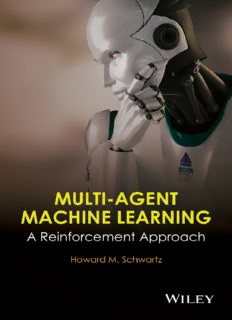
Multi-Agent Machine Learning: A Reinforcement Approach PDF
Preview Multi-Agent Machine Learning: A Reinforcement Approach
Table of Contents Title Page Copyright Preface References Chapter 1: A Brief Review of Supervised Learning 1.1 Least Squares Estimates 1.2 Recursive Least Squares 1.3 Least Mean Squares 1.4 Stochastic Approximation References Chapter 2: Single-Agent Reinforcement Learning 2.1 Introduction 2.2 -Armed Bandit Problem 2.3 The Learning Structure 2.4 The Value Function 2.5 The Optimal Value Functions 2.6 Markov Decision Processes 2.7 Learning Value Functions 2.8 Policy Iteration 2.9 Temporal Difference Learning 2.10 TD Learning of the State-Action Function 2.11 Q-Learning 2.12 Eligibility Traces References Chapter 3: Learning in Two-Player Matrix Games 3.1 Matrix Games 3.2 Nash Equilibria in Two-Player Matrix Games 3.3 Linear Programming in Two-Player Zero-Sum Matrix Games 3.4 The Learning Algorithms 3.5 Gradient Ascent Algorithm 3.6 WoLF-IGA Algorithm 3.7 Policy Hill Climbing (PHC) 3.8 WoLF-PHC Algorithm 3.9 Decentralized Learning in Matrix Games 3.10 Learning Automata 3.11 Linear Reward–Inaction Algorithm 3.12 Linear Reward–Penalty Algorithm 3.13 The Lagging Anchor Algorithm 3.14 Lagging Anchor Algorithm References Chapter 4: Learning in Multiplayer Stochastic Games 4.1 Introduction 4.2 Multiplayer Stochastic Games 4.3 Minimax-Q Algorithm 4.3 Minimax-Q Algorithm 4.5 The Simplex Algorithm 4.6 The Lemke–Howson Algorithm 4.7 Nash-Q Implementation 4.8 Friend-or-Foe Q-Learning 4.9 Infinite Gradient Ascent 4.10 Policy Hill Climbing 4.11 WoLF-PHC Algorithm 4.12 Guarding a Territory Problem in a Grid World 4.13 Extension of Lagging Anchor Algorithm to Stochastic Games 4.14 The Exponential Moving-Average Q-Learning (EMA Q-Learning) Algorithm 4.15 Simulation and Results Comparing EMA Q-Learning to Other Methods References Chapter 5: Differential Games 5.1 Introduction 5.2 A Brief Tutorial on Fuzzy Systems 5.3 Fuzzy Q-Learning 5.4 Fuzzy Actor–Critic Learning 5.5 Homicidal Chauffeur Differential Game 5.6 Fuzzy Controller Structure 5.7 Q( )-Learning Fuzzy Inference System 5.9 Learning in the Evader–Pursuer Game with Two Cars 5.6 Fuzzy Controller Structure 5.10 Simulation of the Game of Two Cars 5.11 Differential Game of Guarding a Territory 5.12 Reward Shaping in the Differential Game of Guarding a Territory 5.13 Simulation Results References Chapter 6: Swarm Intelligence and the Evolution of Personality Traits 6.1 Introduction 6.2 The Evolution of Swarm Intelligence 6.3 Representation of the Environment 6.4 Swarm-Based Robotics in Terms of Personalities 6.5 Evolution of Personality Traits 6.6 Simulation Framework 6.7 A Zero-Sum Game Example 6.8 Implementation for Next Sections 6.9 Robots Leaving a Room 6.10 Tracking a Target 6.11 Conclusion References Index End User License Agreement List of Illustrations Figure 2-1 Figure 2-2 Figure 2-3 Figure 2-4 Figure 2-5 Figure 2-6 Figure 2-7 Figure 2-8 Figure 3-1 Figure 3-2 Figure 3-3 Figure 3-4 Figure 3-5 Figure 3-6 Figure 3-7 Figure 3-8 Figure 3-9 Figure 3-10 Figure 3-11 Figure 4-1 Figure 4-2 Figure 4-3 Figure 4-4 Figure 4-5 Figure 4-6 Figure 4-7 Figure 4-8 Figure 4-9 Figure 4-10 Figure 4-11 Figure 4-12 Figure 4-13 Figure 4-14 Figure 4-15 Figure 4-16 Figure 4-17 Figure 4-18 Figure 4-19 Figure 4-20 Figure 4-21 Figure 4-22 Figure 4-23 Figure 4-24 Figure 4-25 Figure 4-26 Figure 4-27 Figure 4-28 Figure 4-29 Figure 5-1 Figure 5-2 Figure 5-3 Figure 5-4 Figure 5-5 Figure 5-6 Figure 5-7 Figure 5-8 Figure 5-9 Figure 5-10 Figure 5-11 Figure 5-12 Figure 5-13 Figure 5-14 Figure 5-15 Figure 5-16 Figure 5-17 Figure 5-18 Figure 5-19 Figure 5-20 Figure 5-21 Figure 5-22 Figure 5-23 Figure 5-24 Figure 5-25 Figure 5-26 Figure 5-27 Figure 5-28 Figure 5-29 Figure 5-30 Figure 5-31 Figure 5-32 Figure 5-33 Figure 5-34 Figure 5-35 Figure 5-36 Figure 6-1 Figure 6-2 Figure 6-3 Figure 6-4 Figure 6-5 Figure 6-6 Figure 6-7 Figure 6-8 Figure 6-9 Figure 6-10 List of Tables Table 2.1 Table 2.2 Table 3.1 Table 3.2 Table 3.3 Table 4.1 Table 4.2 Table 4.3 Table 4.4 Table 4.5 Table 4.6 Table 4.7 Table 5.1 Table 5.2 Table 5.3 Table 5.4 Table 5.5 Table 5.6 Table 5.7 Table 5.8 Table 5.9 Table 6.1 Table 6.2 Table 6.3 Table 6.4 Table 6.5 Table 6.6 Table 6.7 Multi-Agent Machine Learning A Reinforcement Approach Editors Howard M. Schwartz Department of Systems and Computer Engineering Carleton University
Description: